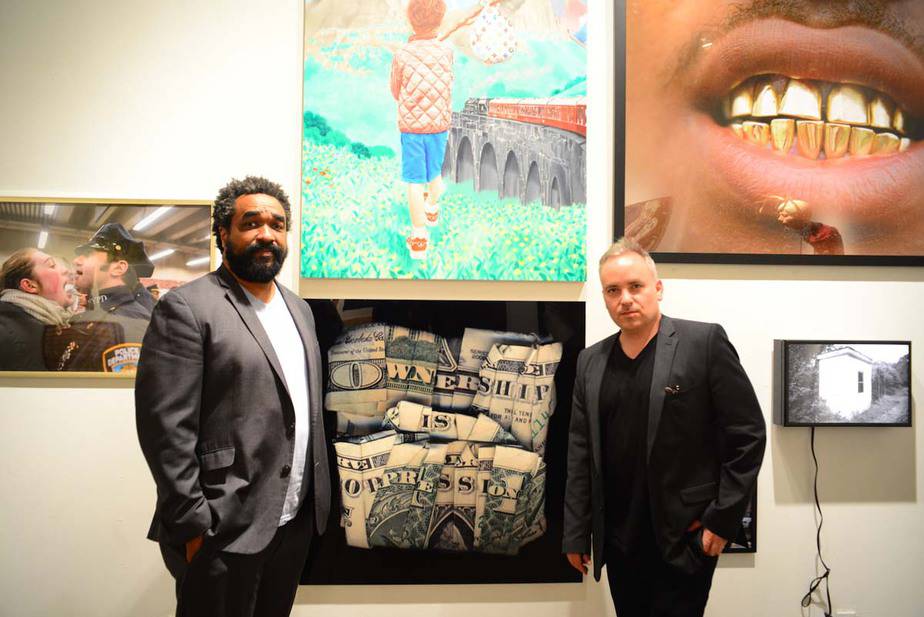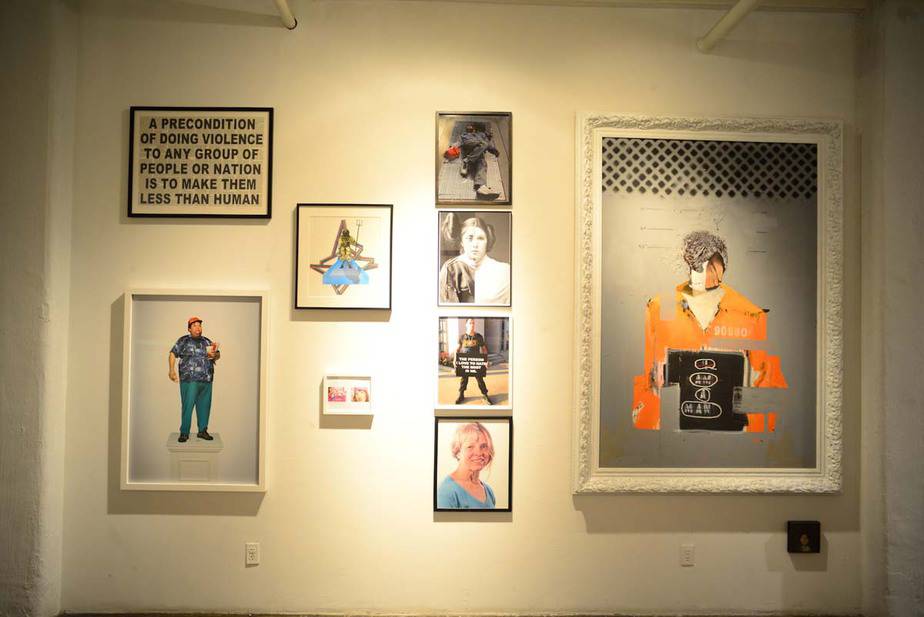6O AMERICANS.
[su_dropcap style=”flat” size=”4″]F[/su_dropcap]uck history… we’re creating something new every year,” pronounced Terrence Sanders, the Editor-in-Chief of ArtVoices Magazine and co-curator of the ongoing exhibition at Elga Wimmer Gallery, 60 Americans.
Co-curator Noah Becker, Editor-in-Chief of Whitehot Magazine, had something similar to say: “People forget that history is something we’re experiencing. It is collected and represented in the art world.”
Together in their incipient partnership—bolstered by their long-term friendship—Sanders, Becker, and Alexander Venet intend to expose critical trends on the pulse of the ‘contemporary American landscape,’ while standing adrift of the ostentatious galleries that pander to short-lists of rich collectors.

Photography by Leon Williams. |
Filmed by Bim Star.
As accomplished visual artists themselves, the three curators drew from their professional as well as academic communities in Los Angeles and the Pacific Northwest, Nevada, Louisiana, New York, and the Northeastern United States to compile an impressive collection of photography, painting, mixed-media collage, and sculpture.
As independent curators, Sanders, Becker, and Venet pledge an alternative to the interests of wealth without dismissing the topic of greed; Artists in this exhibition are sensitive to the immaterial forces that influence the art markets as they do political cycles—the omnipotent crown of social power, divided by wealth and the threat of violence. In the collective voice of the exhibition, certain text rises like speech of public protest: “Ownership is oppression,” spells one of Dan Tague’s origami dollars; nearby, The Citizen X paired a vested officer with the marquee, “The person I love to hate the most is me;”Marcus Jensen’s Faceless Inmate reminds us, “I am a man.”


At another angle, artists offer personal, emotional reactions to their social and cultural landscape. Nicholas Galanin’s split portrait engages memory and symbolic association, while artists like Rebecca Morgan and Bruce Keyes play with the stereotypes and nostalgic romanticization of middle America; Michael Anderson appropriates his environment quite literally, deconstructing New York street posters and rebuilding them in complex narratives.
“I’ve never been one to enjoy the decorative or aesthetic aspects of art,” said Sanders, “When I look at artwork, I want to see the statement.” The current exhibition is vast, the voices distinct and without gimmick; The curatorial statement that skewers mainstream galleries, fairs, “nepotism and favoritism” is certainly contentious, though the roster of museum- and internationally exhibited artists precludes the exhibition from being labeled as an “alternative” show.
60 Americans is more reminiscent of traveling museum shows from the late 20th Century, organized by the Whitney with titles like “American Art Scene,” and “Contemporary American.” The exhibition offers multiple perspectives of a collective, contemporary conscious, which the curators hope to develop into a new art fair, “We can have twenty times the space with the same amount of artists,” Sanders says enthusiastically, “cutting out the gallerist to connect the artist more directly with collectors and enthusiasts.”
Undoubtedly, Noah Becker, Terrence Sanders, and Alexander Venet are three heavyweights to watch.





Mary E. Hurt is a curatorial assistant, art handler, and writer living in Brooklyn. She graduated from Sarah Lawrence College with a degree in Art History in 2013. After a depressing experience working for an infamous vanity gallery in Chelsea, Mary began establishing a freelance network to depend on, assisting established and avant-garde artists in curation, installation, website development, and–most importantly–writing. She is excited to join the staff with Quiet Lunch Magazine and Smoothie Tunes, that dope music interview blog. In upcoming projects, Mary hopes to explore how counter-culture art and music stay alive in an increasingly corporatized playing field.

